South Africa’s flammable floral kingdom
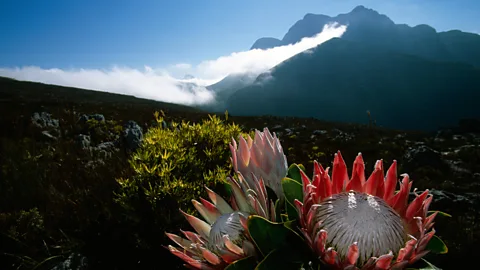 Avalon/Photoshot License/Alamy
Avalon/Photoshot License/AlamyThis scorched shrubland has three times as many plant species as the Amazon rainforest, and needs to burn to survive.
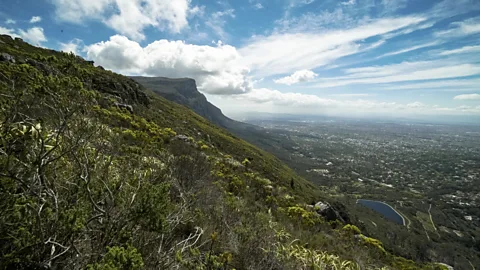 Thomas Lewton
Thomas LewtonLocated near South Africa’s south-western tip, the Cape Floral Kingdom is home to the highest concentration of plant species on the planet. It has three times as many plant varieties as the Amazon rainforest, and 70% of its 9,600 plant species grow nowhere else on Earth. It’s also a flammable ecosystem that needs to burn to survive.
Fynbos (Dutch for ‘fine bush’) covers 80% of the region. While this scrubby green growth may seem unremarkable from a distance, look closer and you’ll see a land of staggering diversity thriving in a vast 90,000-sq-km scorched landscape that’s nearly as large as Portugal.
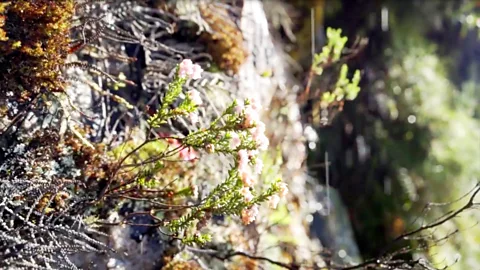 Thomas Lewton
Thomas LewtonSince 2004, much of the sweeping Cape Floral Kingdom, which encomes eight protected areas – including Table Mountain National Park – has been a ed Unesco site. Of the six floral kingdoms on the planet, it’s the smallest. And of the world’s 36 biologically rich and deeply threatened ‘hotspots’ designated by Conservation International, it’s the most diverse.
Hotspots are regions that are home to at least 1,500 endemic plants but have already lost at least 70% of their original vegetation. According to Conservation International, they represent just 2.4% of Earth’s land surface, but more than half of the world’s endemic plant species and nearly 43% of its endemic bird, mammal, reptile and amphibian species.
Table Mountain alone boasts more plant species than the British Isles. And while the Cape Floral Region s for less than 0.5% of Africa’s total surface, it’s home to nearly 20% of the continent’s flora.
 Thomas Lewton
Thomas LewtonThe name ‘fynbos’ encomes some 9,000 plant species that come in almost all shapes, sizes and colours. They range from low-lying shrubs and succulents to spiky reeds and flamboyant orchids, lilies and proteas. These plants blanket rugged mountains, rolling hills, sprawling plains and rock-strewn beaches and can be as diverse as the gnarled branches of the homely rhinoceros bush and the delicate bell-shaped flowers of the Erica.
Fynbos is dominated by four plant families: Protea, Erica, Restio and Geophyte. Proteas, the most famous fynbos, include South Africa’s national flower, the king protea. This plant appears on South Africa’s coat of arms and, according to the South African government, was chosen as ‘an emblem representing the beauty of our land, with the flower representing our potential as a nation in the pursuit of an African Renaissance’.
Due to its various shapes and colours, the Protea genus was named after the Greek god Proteus, who could assume many different forms. All Proteas, from the delicate pink tips of the Leucospermum ‘Spider’ to fireball-red Leucospermum ‘Flame Giant’, have thistle-like flowers and thick woody stems containing dormant buds. These dormant buds can remain inactive underground for decades, but when a fire occurs, it stimulates them to germinate and they emerge in a glorious blaze of colours. Fynbos have evolved so that they need these brush fires to survive, and new shoots start to appear just five days after they burn. Today, South Africa’s cricket team is nicknamed the Proteas because they’re known to bloom after adversity.
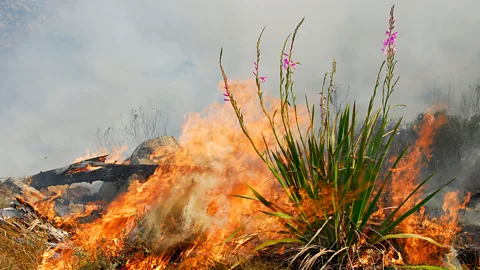 Friedrich von Hörsten/Alamy
Friedrich von Hörsten/AlamyThe Cape Floral Kingdom is a flammable ecosystem that needs to burn every 10 to 20 years in order for seeds to germinate and to destroy invasive species that are not equipped to survive the flames. While the fires used to start by accident during Cape Town’s dry, hot summers, today, most are ‘prescribed fires’ set on purpose by environmentalists and confined to a predetermined area. The ash from these blazes returns minerals to the soil and stimulates new growth. By eliminating invasive species, fire also makes water and light more readily available for the germinating seedlings.
Over millions of years, fynbos have evolved to thrive in sandy, nutrient-poor soil, and to survive South Africa’s windy and hot summers with little rainfall. This makes them ideal vegetation for the drought-prone Western Cape.
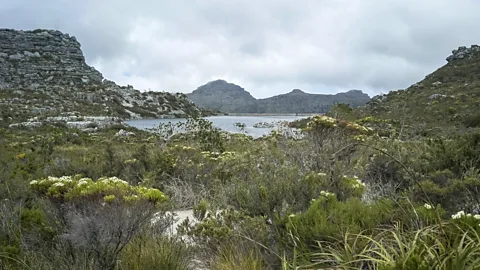 Thomas Lewton
Thomas LewtonCharles Darwin, who visited South Africa in 1836, considered the sight of fynbos to be the highlight of his trip. In his diary, he wrote, “The country is very desert; and with the exception of the pleasure which the sight of an entirely new vegetation never fails to communicate, there is very little of interest.”
After the great Swedish botanist Carl Linnaeus called the Cape Floral Region ‘heaven on Earth’, two other naturalists, Anders Sparrman and Carl Peter Thunberg, travelled around Table Mountain collecting plant species and sending them back to Linneaus in Sweden. Sparrman, in awe of the region’s diversity, described the burning of fynbos: “The ground is, indeed, stripped quite bare; but merely in order that it may shortly afterwards appear in a much more beautiful dress, being, in this case, decked with many kinds of annual grasses, herbs and superb lilies.” Thunberg, known as the ‘father of South African botany’, discovered the popular fynbos Disa orchid.
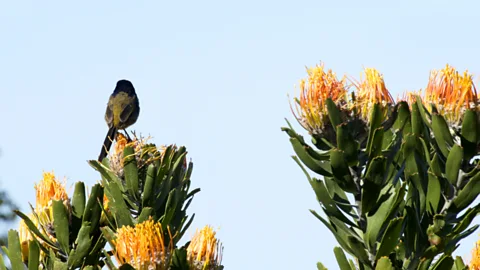 Thomas Lewton
Thomas LewtonThe fynbos biome is home to some 320 bird species, including the orange-breasted sunbird, one of six birds endemic to the region. While the female sunbird is somewhat drab, the male (pictured) shimmers; his iridescent plumage glittering like emerald, ruby, sapphire and citrine gemstones. When taking nectar from flowering Proteas and Ericas, these tiny sunbirds hover like hummingbirds or perch on branches.
The dassie, or rock hyrax, is Table Mountain’s unofficial mascot, and despite looking like a small guinea pig, its closest relative is the African elephant. A number of smaller mammals such as baboons and jackals are dependent on the fynbos for their survival, as are the rare geometric tortoise and the critically endangered Table Mountain ghost frog. Table Mountain is also home to 22 snake species, of which five are deadly and only 10 are non-venomous.
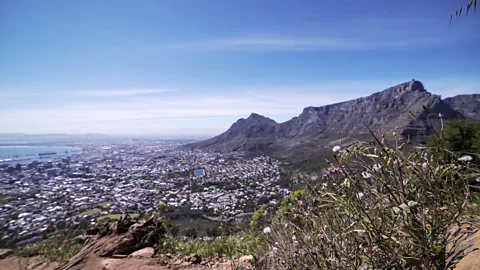 Thomas Lewton
Thomas LewtonAs Cape Town has recently suffered from a severe multi-year drought, it’s imperative to consider the role of fynbos in water conservation. According to Table Mountain expert and hiking guide Dominic Chadbon, 20% of water – or one in every five glasses – consumed by South African residents comes from the mountains of the Western Cape.
Chadbon says that wherever the mountains are covered in fynbos, up to 80% of the rainwater flows into the city’s water supply system. But in areas where fynbos has been replaced by thirsty invasive trees, the amount of mountain water released to the city’s reservoirs is reduced by more than 60%.
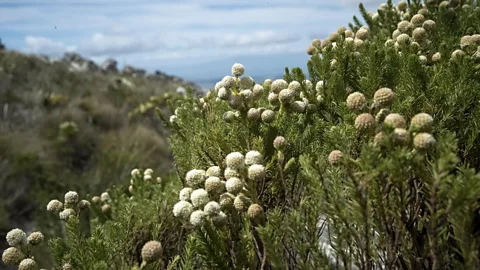 Thomas Lewton
Thomas LewtonAccording to the World Wildlife Fund, there are five major threats to fynbos: urbanisation, alien plant species, irregular fires, global climate change and new forms of agriculture. Cape Town’s population nearly doubled between 1996 and 2011, putting a significant strain on the city’s infrastructure and water resources. Alien plant species also tax the city’s water supply, as they tend to use more water than native vegetation.
One of the most troublesome invasive species, the Australian acacia, was introduced in the 19th Century for timber, to stabilise sand dunes and to provide bark for tanning. Unfortunately, the fast-growing trees have gradually pushed out many native species – including fynbos.
Other non-native plants, like pine and eucalyptus trees also affect the fires that fynbos require, as they cause small, healthy brush fires to swell into much hotter and more intense blazes, which ultimately destroy the plants. Drier winters believed to be caused by shifting global temperatures have made these fires more frequent, which could damage the soil and wipe out slow-growing fynbos. Grape cultivation for wine has also resulted in fynbos being cleared to make way for vineyards.
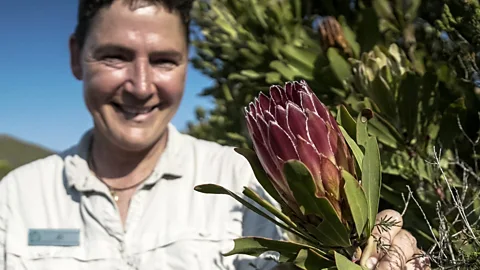 Thomas Lewton
Thomas LewtonIn response to the mounting threats to fynbos’ ecosystem, groups of conservation-minded organisations like the Walker Bay Fynbos Conservancy and government-sponsored associations like the CAPE Programme have banded together to try to ensure the long-term survival of indigenous fynbos vegetation. To date, the CAPE Programme has succeeded in protecting more than 20% of the fynbos biome and it’s hoping to protect up to 30% by 2028.
One of the first steps in preserving fynbos is to remove alien vegetation that crowds out native plants. Conservation groups like the Flower Valley Conservation Trust and the Department of Environmental Affairs’ Working for Water initiative have established programmes to remove non-native plants and are also seeking to prevent irresponsible development and educate the community in sustainable preservation efforts.
 Thomas Lewton
Thomas LewtonOver the last decade, many local companies have started promoting the sustainable use of fynbos. While some fynbos varieties such as rooibos have been used as a drink by indigenous people for hundreds of years, today, fynbos can be found in everything from tea and honey to cosmetics and gin. Fynbos teas and honeys are high in vitamins, minerals and cancer-fighting antioxidants. Sweet rooibos tea has become popular internationally, as have fynbos tea flavours made from buchu, honeybush and rose-scented geranium. Researchers have even found that rooibos and honeybush may contain anti-cancer properties.
At Mayamara, founder Jeanie McFarlane uses fynbos extracts and oils in her luxury cosmetics, and allocated some of her company’s profits to plant 24,000 fynbos plants and thousands of seeds on her land in 2018. Over at Woodstock Gin Company, distiller Simon Von Witt infuses his gins with five to seven different types of fynbos to add, as he says, “herbaceous flavours and a bit of citrus”. Some of the specific fynbos he uses includes rose-scented geranium, which creates “a slightly rosy Turkish Delight flavour”; buchu, which is “slightly minty”; and rooibos, which adds “a very distinctive, dry tannin flavour, but also a citrus undertone and a really nice herby, spicy flavour”.
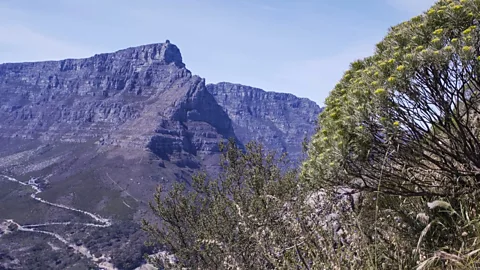 Thomas Lewton
Thomas LewtonWhile South Africa may be known for its safaris across vast expanses of bush and sightings of ‘Big Five’ game animals, a walk amid the fynbos showcases the glory of smaller things.
Two hours from Cape Town, the three-day, 26km Fynbos Trail in the Overberg region takes hikers through more than 800 species of coastal and mountain fynbos. It offers an opportunity to slow down and revel in the infinite variety and beauty of nature.
Encoming the towering majesty of Table Mountain and the windswept Cape of Good Hope, this flammable floral kingdom enchants visitors with a year-round kaleidoscope of rare and exotic flowers that can be seen nowhere else.
(Text by Robin Cherry; video by Thomas Lewton)
World of Wonder is a BBC Travel series exploring some of the most awe-inspiring natural phenomena and man-made marvels around the globe.
